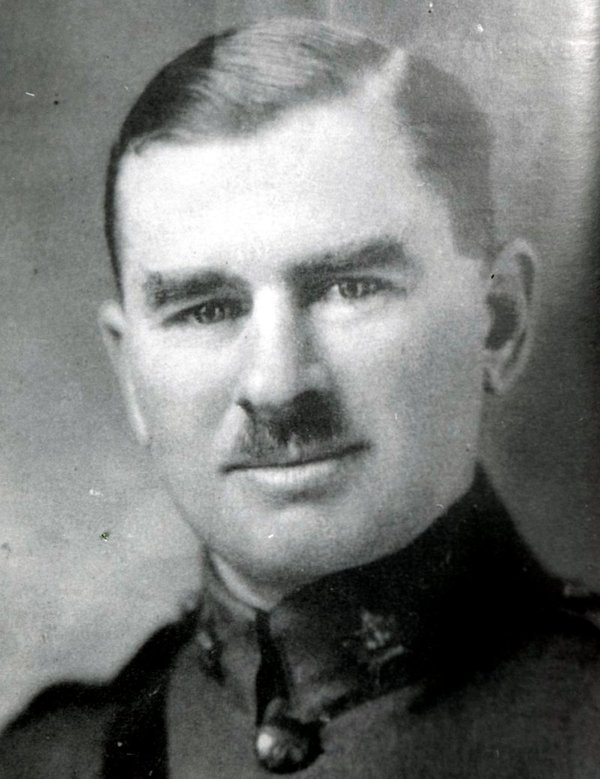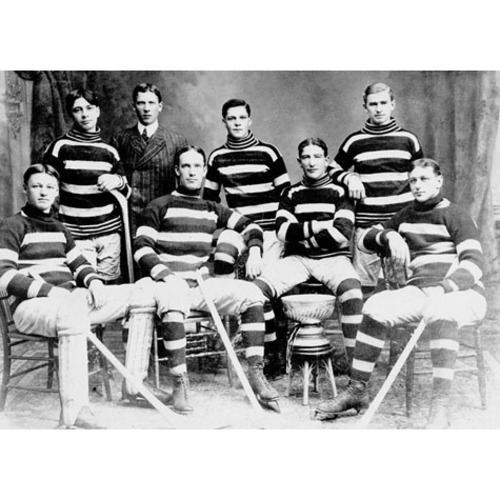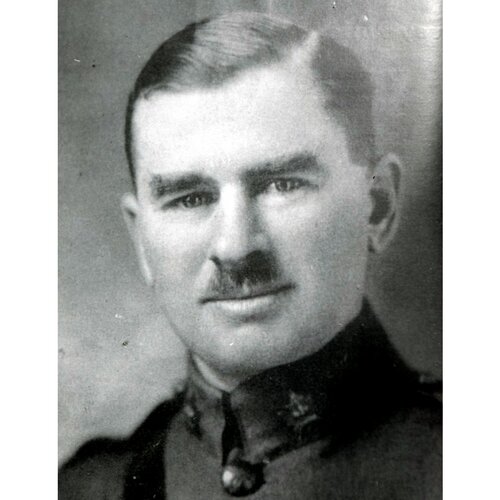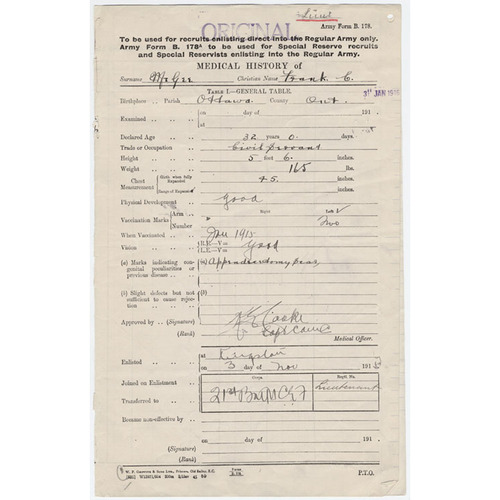
Source: Courtesy of Wikimedia Commons
McGEE, FRANCIS CLARENCE, hockey player, civil servant, and army officer; b. 4 Nov. 1882 in Ottawa, one of at least three sons of John Joseph McGee and Elizabeth Crotty; d. unmarried 16 Sept. 1916 near Courcelette, France.
Frank McGee came from a prominent Canadian family. His father was clerk of the Privy Council and his late uncle, Thomas D’Arcy McGee*, had been a Father of Confederation. After his education in Ottawa, McGee worked for the Department of Indian Affairs, but his passion was sports. An all-round athlete who participated in lacrosse and football, he excelled at hockey, and he had continued to play after losing the sight of one eye in a high-sticking incident when he was a teenager.
McGee’s career in senior hockey began in January 1903 when he joined the Ottawa Hockey Club. In his first game he scored two goals to help the Ottawas, as they were called, defeat the Stanley Cup champions, the Montreal Amateur Athletic Association, 7–1. The Ottawa Citizen reported: “It was McGee’s first appearance as a senior hockeyist and he showed that he was qualified to stay with the finest in the land and finish strong. Frank was at centre and he invariably got the better of the face off. He followed up fast and was always in the vicinity of the puck.”
A few weeks later McGee scored five goals against the Montreal Victorias in a 7–6 Ottawa victory. His accomplishment, then rarely seen at the highest level of hockey, heralded a new era. It was a period which he dominated, averaging better than three goals a game and leading the Ottawas to Stanley Cup championships in 1903, 1904, and 1905. McGee’s 63 goals in 22 cup games is a record for the period before 1918, the year after the National Hockey League was formed. Following the Ottawas’ 1903 championship they became known as the Silver Seven after they were given silver nuggets by team directors to commemorate their first title.
McGee’s nickname was “One-eyed Frank McGee,” which might evoke the image of a rough, hard-bitten warrior. But he was none of these things. He had fine features, was the youngest member of the team, and was noted for always wearing a clean, pressed uniform. Although only five feet six inches tall and having the obvious handicap of sight from only one eye, he was a brilliant play maker and a deadly marksman. He was also intensely competitive and at his best in important games.
McGee’s most famous achievement occurred on 16 Jan. 1905, in a game against the Dawson City Nuggets, who had made a trek from the Yukon for a Stanley Cup series against Ottawa. The Silver Seven had easily won the first game 9–2, but afterwards a player from Dawson said that McGee, who had scored only one goal, had been unimpressive. The remark was reported to McGee, who in the second game set a record for Stanley Cup play that is unlikely to be equalled, scoring 14 goals in a 23–2 Ottawa win.
In addition to being skilled as a player, McGee had a reputation as a practical joker. Some of his jokes were at the expense of his team-mates. One occurred when the Silver Seven dined at Government House with Governor General Lord Minto [Elliot] to commemorate a cup championship. None of the players had been exposed to the etiquette of Ottawa society except McGee, who had told his team-mates to copy whatever he did. When the finger-bowls arrived, McGee picked his up and started slurping the water. His team-mates followed suit and it is said that the governor general too decided it was appropriate to drink from his finger-bowl.
After Ottawa lost the Stanley Cup to the Montreal Wanderers in 1906 McGee, although only 23, decided to retire. The game at this time was extraordinarily violent, and he was risking complete blindness by continuing to play.
At the start of World War I, McGee, an active member of the 43rd Regiment (Duke of Cornwall’s Own Rifles), was mobilized. In May 1915 he embarked for England as a lieutenant in the 21st Infantry Battalion. That December he suffered an injury to his knee in France and was sent to England to recover. He returned to the 21st in August 1916 for the Somme offensive and was killed in action on 16 September near Courcelette.
It is a mystery how McGee got into the army with sight in only one eye. In his certificate of examination the medical officer wrote that McGee could “see the required distance with either eye.” According to McGee’s nephew, Frank Charles McGee, his uncle tricked the doctor. When he was asked to cover one eye and read the chart he covered his blind eye, and when required to cover the other eye he switched hands instead of eyes.
No tricks were needed to get him into the Hockey Hall of Fame, and in 1945 McGee was one of the first players to be inducted. Five years later a poll of sports editors of Canadian newspapers selected the Silver Seven as the country’s outstanding team in the first half of the 20th century.
NA, RG 9, III, 4930; RG 150, Acc. 1992–93/166. Ottawa Citizen, 18 Jan. 1903. C. L. Coleman, The trail of the Stanley Cup (3v., [Montreal], 1964–76), 1. William Houston, Pride and glory: one hundred years of the Stanley Cup (Toronto and Montreal, 1992).
Cite This Article
William Houston, “McGEE, FRANCIS CLARENCE,” in Dictionary of Canadian Biography, vol. 14, University of Toronto/Université Laval, 2003–, accessed November 24, 2024, https://www.biographi.ca/en/bio/mcgee_francis_clarence_14E.html.
The citation above shows the format for footnotes and endnotes according to the Chicago manual of style (16th edition). Information to be used in other citation formats:
| Permalink: | https://www.biographi.ca/en/bio/mcgee_francis_clarence_14E.html |
| Author of Article: | William Houston |
| Title of Article: | McGEE, FRANCIS CLARENCE |
| Publication Name: | Dictionary of Canadian Biography, vol. 14 |
| Publisher: | University of Toronto/Université Laval |
| Year of publication: | 1998 |
| Year of revision: | 1998 |
| Access Date: | November 24, 2024 |





